Hydrodynamic performance and structural response characteristics of the double-slotted vertical cambered V-Type otter board
Wenhu Chu,Gng Chen,Xuchng Ye,Xiufng Cui
a College of Marine Sciences,Shanghai Ocean University,Shanghai,201306,China
b National Engineering Research Center for Oceanic Fisheries,Shanghai,201306,China
c Laboratory of Sustainable Exploitation of Oceanic Fisheries Resources,Ministry of Education,Shanghai,201306,China
d College of Engineering Science and Technology,Shanghai Ocean University,Shanghai,201306,China
A R T I C L E I N F O
Keywords:
Otter board
Hydrodynamic performance
Structural response
Numerical simulation
A B S T R A C T
Vertical cambered V-type otter boards are widely used in large and medium-sized trawlers for their good stability and adaptability to various water layers.However,limited numerical studies on the hydrodynamic performance and structural strength of this type of otter board have been published.In this study,we established the three-dimensional numerical model of the double-slotted vertical cambered V-type otter board according to its special structure and stress feature.We compare the hydrodynamic performance results of our model with those of previous experiments.Using this model,we analyzed the influence of parameters such as attack angle,aspect ratio,dihedral,and deflector angles on its hydrodynamic performance.Moreover,the structural response characteristics of the otter board under typical working conditions were studied.We believe our results will provide theoretical reference for the structural design and optimization of the vertical cambered V-type otter board.
1.Introduction
In the 1980s,Japanese scholars first developed the vertical cambered V-type otter board by introducing the dihedral angle and deflector of wings based on the vertical cambered otter board(Wang,Wang,Zhang,Yu,& Xu,2004).It maintained the good stability of Vtype otter board,and its lift coefficient slightly varied in the range of working attack angle.Moreover,it could be applied to different bottom materials and water layers by slightly adjusting the towing weight of the otter board.Particularly in large trawlers,there was no need to change the otter board from middle water to deep water operation.Thus,it has been widely used in large and medium trawlers in Japan,South Korea,the United States,and other countries(Zhuang,Xing,Xu,& Zhang,2015b).
Scholars from several countries have made different achievements on various types of otter boards(Fernando,Joana,Emilio,&Antonello,2016;Liu et al.,2013;Liu et al.2014;Liu et al.2015a;Liu et al.2015b;Liu et al.2017a;Liu et al.2017b;Rao,Huang,Yang,Li,&Chen,2018;Rao,Huang,Li,Chen,& Yang,2019;Takahashi,Fujimori,Hu,Shen,&Kimura,2015;Wang et al.,2015;Wang et al.2017;Wang et al.2017b;Xu et al.,2018b;Xu et al.2017a;Xu et al.2017b;Xu et al.2018a;Zhuang et al.,2015a),while the research on the performance of the vertical cambered V-type otter board was first started in Japan in the 1990s.Ko et al.(Ko,Hu,& Satoshi,1990)studied the maximum lift coefficient and lift-drag ratio of the vertical cambered V-type otter board in the range of common working attack angle.Chang et al.(Park et al.1993,1996)used a single factor test method to study the influence of plate curvature,dihedral and sweepback angles on the hydrodynamic performance.China began to introduce the vertical cambered V-type otter board in the 1990s,and then domestic scholars started to study its hydrodynamic performance.Wang et al.(Wang et al.,2004)analyzed the relationship between the otter board structure and its hydrodynamic performance using the orthogonal test method,and investigated the influence of the dihedral angle,sweepback angle and aspect ratio on its hydrodynamic performance.Rao et al.(Rao et al.,2015)carried out theoretical research on the mechanical matching calculation in the trawl system based on experimental data.
These previous research are based on experiments and theoretical calculation,while the numerical simulation on its performance has rarely been published thus far.In addition,the otter board is subject to coupling effects of several loads such as fluid pressure and tension of warp and sweep.Thus,it is necessary to analyze the structure strength of its main components.In this study,based on numerical technology,we investigated the hydrodynamic performance and structural response characteristics of the vertical cambered V-type otter board according to its structural form and mechanical characteristics during operation.We strongly believe our work could provide theoretical reference for the structural design and optimization of this type of otter board.
2.Materials and methods
2.1.Governing equation
It is assumed that the fluid is incompressible and isotropic,and the governing equations include the continuity and the Navier-Stokes equations:

2.2.Parameter definition
The main parameters describing the hydrodynamic performance of otter board are lift coefficientCl,drag coefficientCdand lift-drag ratio K,whose calculation formulas can be described as follows:

where ρ is the fluid density,Vis the velocity of the otter board relative to fluid,with value of 2 m/s in calculation,Sis the projected area of otter board,with value of 9.6 m2,Flis the lift force,andFdis the drag force.
2.3.Numerical model of the otter board
A 1:1 in this study,we carried out three-dimensional numerical model of the double-slotted vertical cambered V-type otter board,as shown Fig.1(a).Based on it,we employed methods of computational fluid mechanics(CFD)and finite element method(FEM)to analyze the hydrodynamic performance and structural response of the otter board.The main structural parameters that affect the hydrodynamic performance of the double-slotted vertical cambered V-type otter board were shown in Fig.1(b),where the chord l is 2.36 m,the span b is 4.02 m,the deflector angleβis 15° and the dihedral angleγis 6°.
3.Results and discussion
3.1.Parameters for the hydrodynamic performance calculation of the otter board
The hydrodynamic performance calculation model of the doubleslotted vertical cambered V-type otter board was shown in Fig.2.The calculated area size was 60×10×20 m.The hexahedral(structural)and the tetrahedral(non-structural)meshes were selected in the near and far-field region of the otter board for calculation,respectively.The upstream inlet was set as the velocity inlet boundary with the velocity ofV=2m/s in the X direction,while the downstream outlet was set as fully develop free outflow boundaries.The surface of the otter board and the boundary of calculation field were set as no-slip wall.We select the turbulence model as the standard model.
3.2.Verification of the numerical model
In order to verify the validity of our numerical model,results of the numerical calculation of the hydrodynamic performance were compared with those of previous flume model tests[15],as shown in Fig.3.The shape and size of the calculation model were geometrically similar to that in the test model(The test model adopted the Reynolds similarity criterion,with a scale of 1:20 and an area of 0.024 m2,and the calculated model in the paper was 9.6 m2).The attack angle was set between 0° and 70°,with an increase of 10° for each calculated condition,while the flow velocity was set as 2 m/s.
Fig.3 shows that the calculation results of our established numerical model were in good agreement with the test results of the vertical cambered V-type otter board,although there were some differences in the obtained values.Compared with the test results,the lift coefficientClobtained by numerical simulation was larger in the descending section,while the drag coefficientCdwas smaller in the ascending section.This is probably due to the fact that the numerical model was more ideal for the flow state and boundary conditions,while there were some factors such as interference and boundary effect in the flow filed during the flume model test.However,comparison between the two group of curves could still verify the validity of the calculated results in this paper within the acceptable error range.
3.3.Hydrodynamic performance analysis
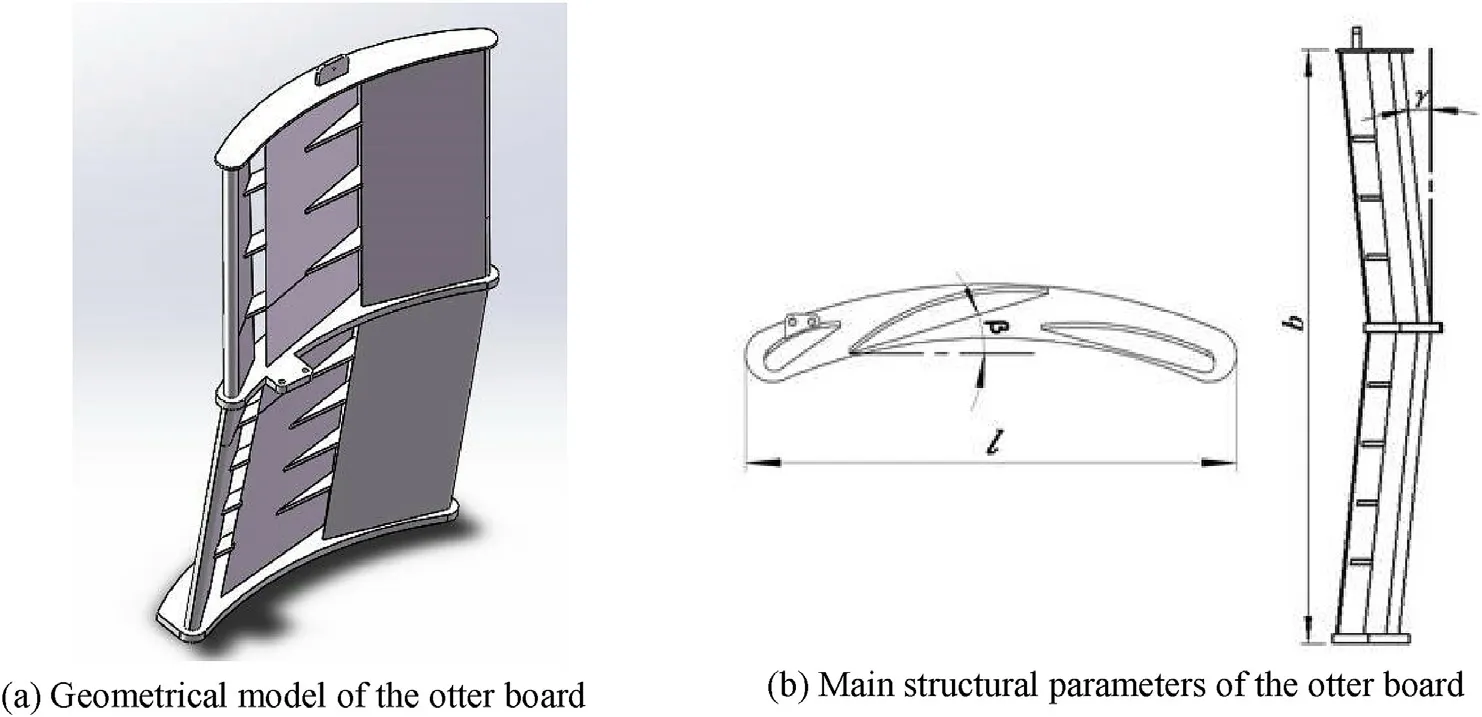
Fig.1.Numerical model of the double-slotted vertical cambered V-type otter board.(a)Geometrical model of the otter board.(b)Main structural parameters of the otter board.

Fig.2.Numerical model for the hydrodynamic performance calculation of the otter board.
Based on the verified effective numerical model,we calculated and analyzed the hydrodynamic performance and its influencing parameters of the double-slotted vertical cambered V-type otter board.
Fig.4 shows the velocity and pressure distribution of the flow field around the otter board under different attack anglesin which the flow velocity was set at 2 m/s.To observe the distribution of the flow field clearly,three typical sections of the otter board(upper,middle and lower)were selected to show the results.It can be observed that there are obvious eddies near the inflow surface and backflow surface of the otter board when attack angleα=0o,while the flow field around the otter board became more uniform whenα=10o~30o,and only the tail vortex was generated due to the separation of boundary layer.At the same time,the surface pressure difference between the inflow and backflow of the otter board has gradually became obvious as the attack angle increased,which corresponds to gradual increase of the lift force of the otter board.Thereafter,as the attack angle continued to increase,the inflow area significantly increased,and the boundary layer separation point moved forward.Large area eddy current was observed near the backflow surface of the otter board,which dominated the flow field gradually and caused significant decline and increase of lift and drag forces respectively.In addition,the larger inflow area would inevitably lead to the further increase of drag force,and under the combined action of them,the lift-drag ratio decreased sharply.
Fig.5 further showed the coefficientCl,Cdand K changed with the attack angle.It could be intuitively observed that,as the attack angle increased,the lift coefficientClincreased first and then decreased within in certain range,reaching the maximum value at aboutα=30o.This was well explained in Fig.4(d)and(e).When the attack angle reached at about 30°-40°,the eddy current area on the back flow surface of the otter board reached the maximum,and the pressure difference between the surfaces of inlet and back flow surfaces also reached its peak.The drag coefficientCdcontinuously raised with the increasing attack angle in the range of 70°.The main reason was that the inlet flow area of the otter board continued to increase with the rising of attack angle.As seen from Fig.5(a),when the range of attack angle was less than 15°,the lift coefficientClrose rapidly as the drag coefficientCdincreased slowly.As a result,lift-drag ratio K first increased and then decreased as the attack angle increased,and the peak appeared when the attack angle was about 13°,as shown in Fig.5(b).In the actual production operation,when the lift coefficient and lift-drag ratio were taken into comprehensive consideration,the operating attack angle could be set as 10°-35° to ensure the higher operating efficiency.
3.4.Influence parameters analysis on the hydrodynamic performance
3.4.1.Influence of the aspect ratio on hydrodynamic performance
Aspect ratio is undoubtly one of the key parameters that affect hydrodynamic performance of the otter board among many structural parameters.The same type of otter board with different aspect ratio may have different performance.In order to analyze the influence of the aspect ratio on hydrodynamic performance of the double-slotted vertical cambered V-type otter board,different aspect ratio values of 1.2,1.5,1.7,1.9 and 2.1 were selected on the basis of our proposed numerical model,and their hydrodynamic performance corresponding to the same flow velocity and attack angle were calculated and compared.
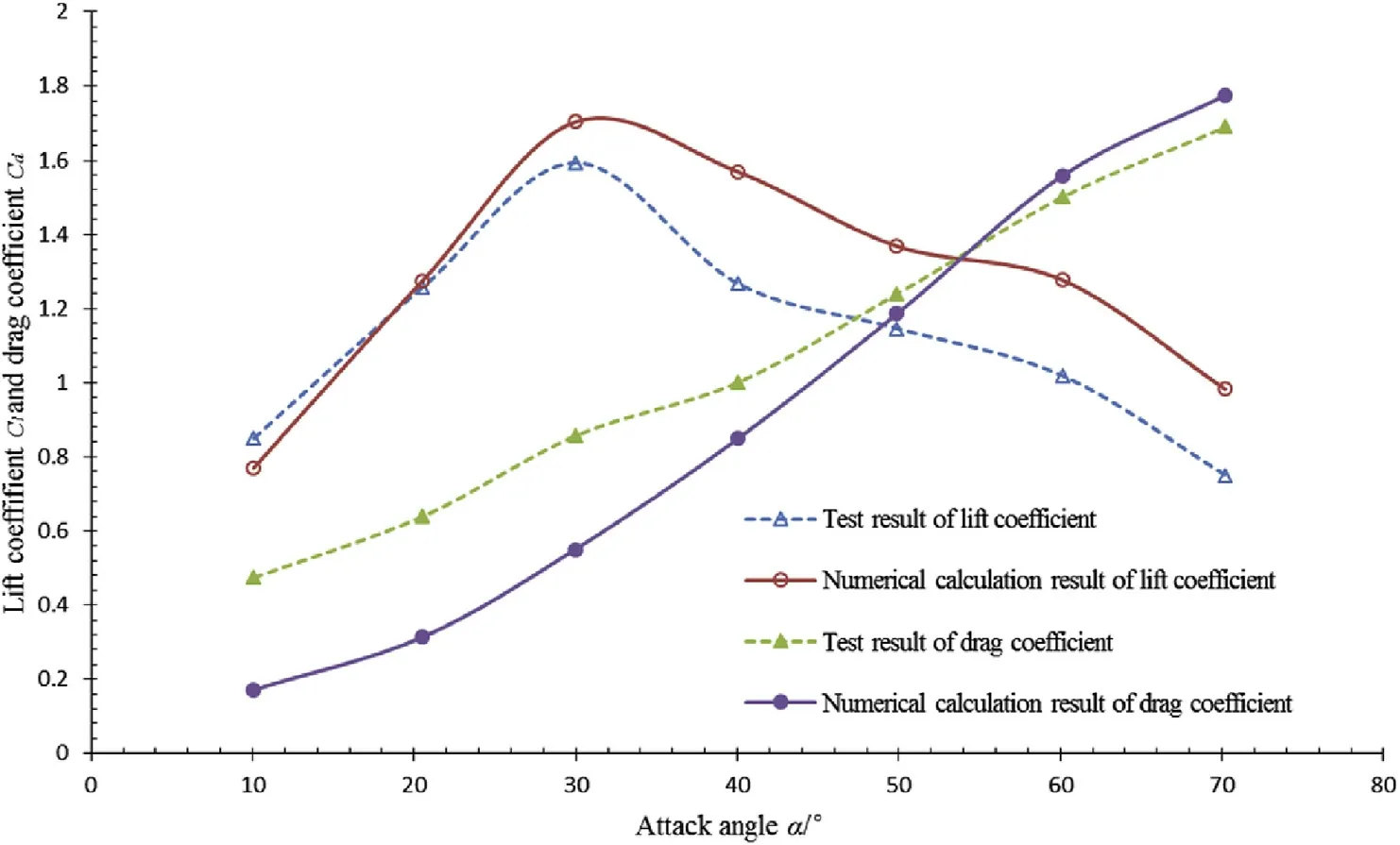
Fig.3.Comparison of hydrodynamic performance between numerical simulation values and experimental results.
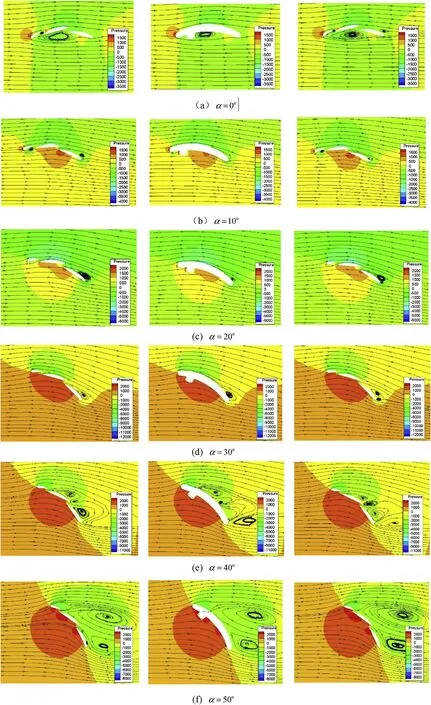
Fig.4.Velocity and pressure distribution of the flow field around otter board under different attack angles.
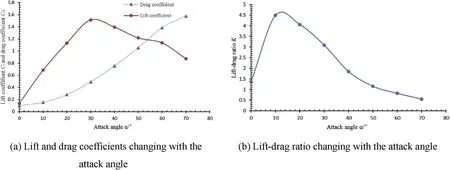
Fig.5.Hydrodynamic coefficients of the double-slotted vertical cambered V-type otter board changing with attack angle.
Fig.6 showed the coefficientsCl,Cd,and K changing with the aspect ratio of otter board.It can be observed that the aspect ratio had a significant influence on the lift coefficient.Since the area of the otter board was basically unchanged when the aspect ratio was set in calculation,as the aspect ratio increased,the wing span increased while the wing chord decreased.Then the flow pattern around the otter board was improved as the lift force significantly increased,while the drag coefficient changed little with it.Under their combined action,the liftdrag ratio increased obviously with the increasing aspect ratio.It could be concluded that the increase of aspect ratio would undoubtedly bring beneficial effects to the improvement of operation efficiency of the otter board.It should be considered that in addition to the highest lift-drag ratio as far as possible,the otter board should also be ensured to have good stability in the operation process.However,the increase of aspect ratio would lead to the increase of the center of gravity,which would negatively affect the stability of the otter board.Therefore,the aspect ratio of the vertical otter board cannot be increased indefinitely.The selection of aspect ratio in the design process of otter board needs to be determined by comprehensive consideration of lift-drag ratio and stability.
3.4.2.Influence of the dihedral angle on hydrodynamic performance
Previous research[1]indicates that the most important factor affecting hydrodynamic performance of the vertical cambered V-type otter board was its dihedral angle,which even exceeded the aspect ratio.Thus,it is a key factor that cannot be ignored in studying the hydrodynamic performance.In this study,we set the dihedral angle of the otter board as 4°,6°,8°,10°and 12°respectively on the basis of the basic numerical model,and then calculate their hydrodynamic performance at the same flow velocity and attack angle.At the same time,in order to avoid the influence of aspect ratio change,which was caused by the change of the dihedral angle,the size of the otter board was adjusted appropriately to determine the aspect ratio to be fixed when changing the dihedral angle.
Fig.7 showed the coefficientsCl,Cdand K changing with the dihedral angle of the otter board.It could be observed that the lift coefficient and drag coefficient had no obvious change trend with the increase of the dihedral angle,while the lift-drag ratio showed a more significant change law.With the increasing dihedral angle,the lift-drag ratio of the double slotted vertical cambered V-type otter board increased first and then decreased,and it reached the peak when the dihedral angle equaled about 6°,which might be the best dihedral angle for design.Because the aspect ratio and the projected area of the otter board were strictly controlled when changing the dihedral angle,the above results could be regarded as the influence law of the single variable(dihedral angle)on hydrodynamic performance of the otter board.The main reason for the consideration of this law was that under the same attack angle,the change of the dihedral angle caused the velocity and pressure distribution changing in the flow field near the inflow and backflow surfaces of the otter board,which would lead to the change of lift and drag forces to different degrees respectively.When the dihedral angle was small(less than 6°),its increase caused slight decrease in the drag force it while the lift force remained basically unchanged,so the lift-drag angle showed an upward trend.When the dihedral angle exceeded 6°,its increase caused the lift force to decrease while the drag force slightly increased,resulting in letting the lift-drag ratio present an obvious downward trend.
3.4.3.Influence of the deflector angle on hydrodynamic performance
Since the vertical cambered V-type otter board in our study was double slotted,the change of deflector angle will inevitably affect the size of the slot and the flow field distribution near the inflow and backflow surfaces of the otter board,which may have a significant impact on its hydrodynamic performance.The deflector angle of the otter board was set as 5°,10°,15°,20°and 25°respectively on the basis of the basic numerical model,and then their hydrodynamic performance at the same flow velocity and attack angle were calculated.
Fig.8 shows the coefficientsCl,Cdand K changing with the deflector angle of otter board.It can be observed that the lift coefficientClincreased first and then decreased with the increasing deflector angle,while the drag coefficientCddid not change significantly.Thus,the liftdrag ratio K also first increased and then decreased due to their combined influences.Both the maximum lift coefficient and the maximum lift-drag ratio appeared when the deflector angle was about 10°.We believe the main reason of this phenomenon as the change of deflector angle caused the change of slot size and inflow surface area.In the range of small deflector angle,the inflow surface area of otter board changed little,and the change of slot size played a dominant role.The increase of slot size optimized the distribution of flow field around the otter board,and the lift force increased accordingly.When the deflector angle exceeded a certain range,the inflow surface area decreased significantly as it increases,which would cause gradual decrease in the spreading tension(lift force)of the otter board.
3.5.Structural response characteristics of the double-slotted vertical cambered V-type otter board
In the working process of trawling fishing gear,the otter board is affected by both the tension of the wire and the hydrodynamic load,and these loads change constantly with the movement of the otter board.For the otter board structure,it must have enough structural strength and mechanical properties to work continuously and stably under the action of these typical loads.Otherwise,the otter board structure will suffer different degrees of damage,thus affecting its working performance.In order to accurately analyze the structural response mechanism of the otter board structure during working operation,based on the hydrodynamic performance analysis above,we calculated the structural response characteristics of the otter board under the coupling action of the cable tensile force and hydrodynamic load.
The finite element method was used to conduct the numerical analysis of the structural response of double-slotted vertical cambered V-type otter board,and the numerical model was established as shown in Fig.9.The otter board model was established using body elements,with a total of 510000 units.The loads were connected by MPC LINK to simulate the tensile forces of the sweep and warp on the otter board during operation.The otter board had a weight of 30000 N in water.The velocity of the warp was 2 kn.The length of the sweep was 100 m,with a diameter of 25.5 mm and a unit weight of 19.17 N/m in water.The tensile force of it was 15981 N[24],and that of the warp was obtained by balancing with sweep tensile and hydrodynamic forces.
Fig.10 showed the stress distribution of the inflow and backflow surfaces of the otter board under different attack angles.It could be observed that the maximum stress at different attack angles mainly appeared at the joint position of the cable(sweep and warp)and otter board.With the increasing attack angle,the area of larger stress value affected by the sweep and warp was also enlarged.As such,we believe that the area near the connection point between the cable and otter board need to be specially strengthened in the process of structural design,and the area of the structural strengthening should be appropriately raised with the increasing working attack angle.
4.Conclusions
We established and verified the three-dimensional numerical model of the double-slotted vertical cambered V-type otter board,according to its actual structure and mechanical character.On this basis,its hydrodynamic performance and structural response were calculated and analyzed,and the obtained main conclusions can be described as follows:
1)The lift coefficientClof otter board first increased and then decreased with the increasing attack angle within the range of 70°,while the drag coefficientCdcontinuously increased.As a result,the lift-drag ratio K showed its peak at about 13°.
2)The aspect ratio had a significant influence on the lift coefficient,while the drag coefficient changed little.Under their combined action,the lift-drag ratio increased obviously with the increasing aspect ratio.It could be concluded that the otter board with a larger aspect ratio was an ideal choice for the nets requiring higher lift coefficient and lift-drag ratio.However,the increase of aspect ratio also caused decrease in the stability of otter board.Thus,the selection of aspect ratio should be determined by taking into account both the operation efficiency and stability in the otter board design.
3)With the increase of dihedral angle,the lift-drag ratioClof double slotted vertical cambered V-type otter board increased first and then decreased,and reached the peak when the dihedral angle equaled about 6°.The main reason for this phenomenon was considered that under the same attack angle,the change of the dihedral angle caused the velocity and pressure distribution changing in the flow field near the inflow and backflow surfaces of the otter board,which would lead to the change of lift and drag forces to different degrees.
4)The lift coefficientClfirst increased and then decreased with the increasing deflector angle,while the drag coefficientCddid not change significantly.The lift-drag ratio K showed the same changing rule under their combined influences.Maximum values of both the lift coefficient and lift-drag ratio appeared when the deflector angle was about 10°.
5)Under the coupling action of the cable(sweep and warp)tensile and hydrodynamic forces,the maximum stress of the otter board structure mainly appeared at the joint position of the cable and otter board.As the attack angle increased,the area of larger stress value affected by the sweep and warp was also enlarged.
Author agreements
No conflict of interest exits in the submission of this manuscript.All authors above have approved the final manuscript.
Author contributions
Wenhua Chu:conceived and designed the numerical simulation;drafted and revised the manuscript.
Gang Chen:conducted the calculaiton;critically read the manuscript.
Xuchang Ye:helped perform the analysis with constructive discussions.
Xiufang Cui:critically read the manuscript;revised the manuscript.
Acknowledgements
This research was supported by the National Natural Science Foundation of China(31972845)and the Open Fund of National Engineering Research Center for Oceanic Fisheries(A1-2801-18-100401-7).
Appendix A.Supplementary data
Supplementary data to this article can be found online at https://doi.org/10.1016/j.aaf.2019.12.003.
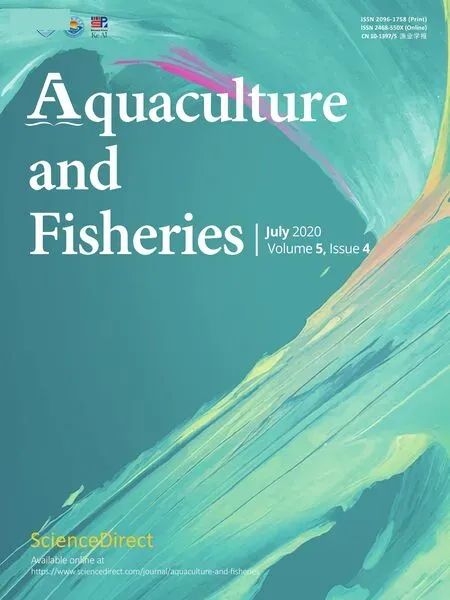 Aquaculture and Fisheries2020年4期
Aquaculture and Fisheries2020年4期
- Aquaculture and Fisheries的其它文章
- Genomes of major fishes in world fisheries and aquaculture:Status,application and perspective
- The economic contribution of fish and fish trade in Bangladesh
- Eye location,cranial asymmetry,and swimming behavior of different variants of Solea senegalensis
- Effect of chicken haemoglobin powder on growth,feed utilization,immunity and haematological index of largemouth bass(Micropterus salmoides)
- Effect of the number of freeze-thaw cycles number on the quality of Pacific white shrimp(Litopenaeus vannamei):An emphasis on moisture migration and microstructure by LF-NMR and SEM
